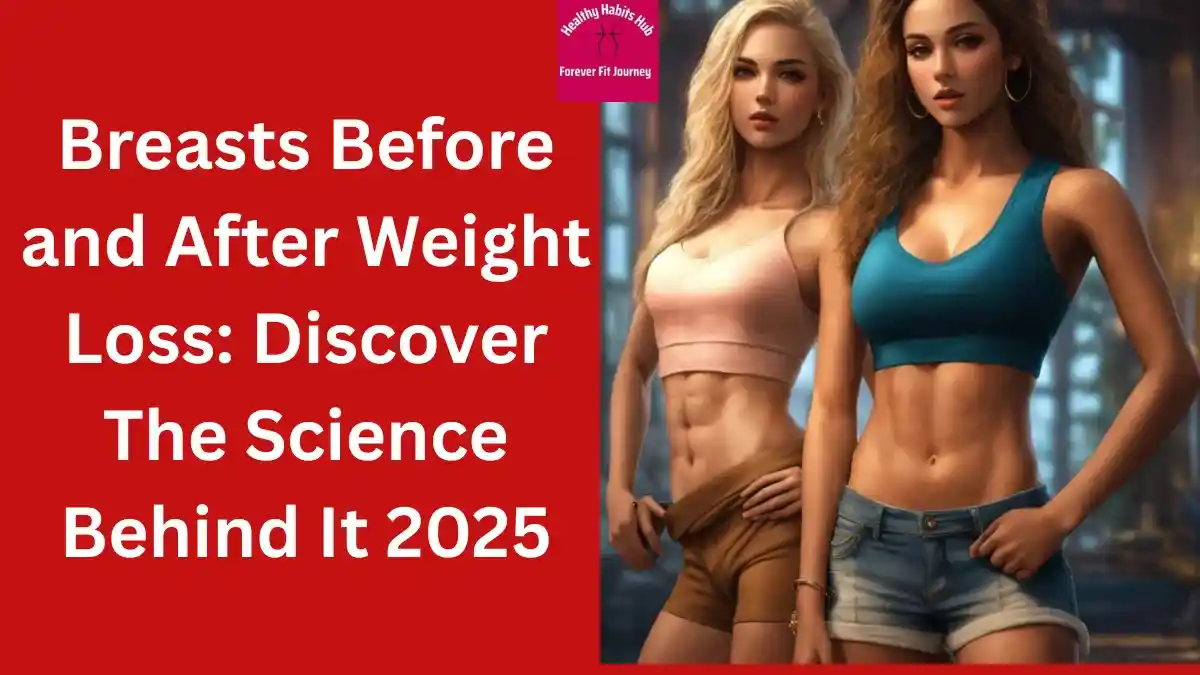Introduction: Understanding the Impact of Weight Loss on Breast Size
Breasts before and after weight loss: Many of us focus solely on the weight on the scale or the size of our clothes when we decide we want to start a weight loss journey. One change most people are aware of is probably the most expected in the breasts. Fat forms a large part of breast tissue, which means that the breasts may react directly to changes in weight.
When weight is lost, breast shape, size, and firmness can alter, and the results are often not what the patient expects. The above problem statement is in response to why this occurs, and taking care of your body during and following weight loss should be critical to not just physical but emotional wellness as well.
Why Does Breast Size Change with Weight Loss?
Why breasts most often reduce in size with weight loss has to do with the composition of the breasts. Breasts are glandular tissue and fat, not muscle and bone, like other parts of the body. And the fat in the breasts is susceptible to the body-fat percentage fluctuations that come with weight loss. As overall body fat declines, the fat in the breasts declines. Furthermore, a very important factor in breast size is fat. Actually, whilst 20% of breast tissue is glandular tissue and connective tissues, roughly 80% is fat. Though it influences their appearance and feel as well, fat gives them bulk and form.
Breasts Before and After Weight Loss: How Fat Tissue’s Function in the Breasts
Breasts that are fuller of fat may be more prominent and firmer. When we lose weight, we are fat-burning to a large extent. Since breasts are mostly made of fat, they are also affected. Over time, this can result in a loss of fullness and, in some cases, softness and loss of firmness.
Everything You Need to Know About the Effects of Weight Loss on Your Body
Nobody loses weight in the same way, shape, or form — having different body composition, genetics and activity levels. Although changes in the breasts are frequently the most visible result, the entire body becomes altered. Fat is removed from different locations, but certain parts of the body may be more affected than others. Breasts are one of the first areas to lose fat, especially in women with more body fat to start with. Explaining the overall picture of losing weight goes beyond just the visible changes. It leads to realizing that other factors are in play, like hormones and genes, whereby individuals can develop a realistic idea of how their body will transform over time.
Understanding breast anatomy is essential before starting a weight-loss journey. We must explore their anatomy in detail to grasp how breasts change with weight loss.
What Are Breasts Made Of?
The breast is a complex structure made up of a variety of different tissues. Breasts are made up of two primary types of tissue: glandular tissue and adipose (fat) tissue. The lobes, ducts, and connective tissue contain the specialized glandular tissue that produces milk. Fat tissue, in contrast, encases the glandular tissue and gives it bulk, cushiness, and contour. The proportions of each type of tissue differ from one individual to another and are frequently affected by genetic and hormonal factors.
Fat, Glandular Tissue and Skin: What Shapes Your Breast Size And Appearance
Like the structure of the breast, which is made up of fat, glandular tissue, and skin that interact in a particular way to give the breast a specific shape, fat gives your shape and fullness, and the gland tissue gives density and firmness. Skin elasticity is essential, too, since it stretches to fit the size and shape of the breast.
What Are Hormones and Breast Density?
Hormones, especially estrogen levels, play a significant role in breast growth and sustenance. Estrogen has various functions controlling how much fat is stored in the breasts, which is why many women report breast size changes during times when hormones change, such as in pregnancy, menopause, or from the use of the contraceptive pill. Megan says these fluctuations can also impact how the breasts react to weight loss. For example, lowered estrogen levels during menopause may also contribute to volume loss in breasts, even in the absence of weight loss.
What occurs to Your Breasts When You Lose Weight?
Losing weight sets off a chain reaction of changes in the body, and the breasts are no different.
Shifts in the Location of Fat throughout the Body
The body tends to burn fat from all over, but fat distribution does not always happen evenly. Some people may lose more fat on their stomach or thighs, while others may lose it primarily from their upper body, including the breasts. The answer lies in the repartitioning of fat loss within the same region, something that can vary greatly depending on genetics and overall composition.
The Reason Breasts Are Usually One of the First Places You Lose Fat
There are several reasons. Breasts lose fatty mass faster than the rest of the body. First, the breast tissue is primarily fat. The body has a second secret when it comes to utilizing its energy stores; it is highly efficient at mobilizing fat deposits stored in parts of the body that are not essential for living. Because breasts are not another organ that your body may use as a guide to prioritize fat loss, fat is more likely to come off the breast area when we burn fat. So, the size of the breast will considerably drop at the beginning of the weight loss process.
How Skin Elasticity Affects Your Post-Weight Loss Appearance
Skin elasticity significantly affects how the breasts look post-weight loss. Skin that is incapable of expanding and contracting leaves it sagging or loose. Familiar with rapid or extreme weight loss, in which the skin did not have enough time to adjust. Keeping skin supple with hydration, appropriate skin care, and light massage can lessen this effect, but it is not always avoidable.
Are You Getting an Idea of Why: Breast Size and Shape Factors Before Weight Loss
Breast size and shape before weight loss are dependent on many processes.
Genetic Inheritance Affecting Breast Development
Genetics is a significant factor that determines breast size and shape. A person’s family history is an essential determinant of how much fat and glandular tissue is found in their breasts. Genetics, too, affects the baseline density and volume of breast tissue, which can determine how much change is seen after weight loss.
2020 American Society of Plastic Surgeons.
The composition of breast tissue changes naturally as women age. The amount of glandular tissue diminishes, and fat tissue increases, changing the body’s shape and stiffness. This process can be amplified during weight gain and loss, so women over 40 might experience more dramatic shifts in breast size during weight loss compared with younger folks.
ON PREGNANCY AND BREASTFEEDING How They Change Breast Tissue
Pregnancy and breastfeeding are remarkable events that change the architecture of breast tissue. Pregnancy brings about hormonal changes that make the breasts expand, and the glandular tissue enlarges in anticipation of milk production. Breasts usually return to a new size and shape, which may be larger or smaller after nursing. The loss of weight after pregnancy can also be more pronounced with these changes.
The Hormonal Hostage: Birth Control, Menopause, and Breast Size
Breast size can also change thanks to hormonal changes, like those caused by birth control or menopause. Birth control pills, for example, can cause temporary swelling and tenderness in the breasts, while menopause causes the body to produce less estrogen, which may lead to breast shrinkage. Making sense of these hormonal influences is essential to navigating weight loss and the resulting breast changes.
Methods Of Weight Loss and Their Effect on The Breasts
Weight loss methods have different effects on the breasts.
How Dieting Affects Your Bust
Dieting, particularly severe calorie restriction, leads to fat loss, including in the breasts. A well-balanced diet maintains healthy weight loss and not only lowers the risk of unwanted fat loss from the breast but also helps to reduce excessive fat loss at your breasts specifically. However, rapid weight loss can cause drastic changes. It’s essential to lose weight sustainably so you don’t lose a substantial amount of breast size.
That’s where exercise comes in.
Though it won’t directly eradicate breast fat, exercise can build up the underlying muscle tone, which improves the overall appearance and firmness. Exercises that work the chest, like push-ups, chest presses and flies, build up the muscles that support the breasts, helping to improve shape as fat decreases.
What Changes to Expect After Weight Loss
Significant changes to the breasts often occur after weight loss, and it may be essential to know what to expect.
Shrinking of the Breast Tissue
When we lose fat from the body, fatty tissue is lost from the breast, which can lead to a visible decline in its size. This shrinkage can be even more noticeable in women with larger breasts because they have more fat tissue.
Sagging and Loss of Firmness
Sagging, medically known as ptosis, occurs when the skin loses elasticity and the breasts no longer retain their former shape. Breast volume loss, along with the sagging of the skin, causes drooping. This is especially common following rapid or extreme weight loss.
Why Skin Mightn’t Adjust to Rapid Weight Loss
When you lose weight in a hurry, your skin can’t shrink back down quickly enough to match your new body size, which may leave you with loose, wrinkly skin. This problem is widespread in those who shed a great deal of weight quickly.
Predictions you can make based on a body type and the expected type of breast changes
Weight loss affects different body types and breasts in various ways.
The Effect of Weight Loss on Small Breasts Vs. Large Breasts
Women with larger breasts typically experience a more pronounced decrease in their size, as their bosoms are made with a more significant percentage of fat tissue. Women with tiny busts, however, might only see slight differences in fullness. However, the shape or firmness of both groups can be altered by weight loss.
Breasts Change for Pear-Shaped vs Apple-Shaped Bodies
Fat loss also depends on where you carry your weight. Women with a pear shape lose more weight from the lower-body area, so the upper body, including breasts, becomes a lot less affected. Women with an apple shape, on the other hand, tend to see their breast size reduce more dramatically as they lose weight from the top of their bodies first.
Societal Pressures and the Loss of Breast Size After Weight Loss
The modification of the breasts due to weight loss can cause and lead to physical, emotional, and psychological issues.
How Your Perception of Yourself Can Change After Losing Weight
A lot of people who lose weight are also affected in their self-esteem by the size of their breasts after they lose weight. Some may feel more confident in that bow than others, and some (those who associate their breasts with signs of femininity, perhaps) may feel disappointed.
Overcoming Mental Barriers After Weight Loss
If you don’t realize that specific changes are inevitable, like sagging or a reduction in breast volume, it can cause insecurities. These adjustments can provide an avenue toward body positivity, which is essential to being able to manage insecurities far better.
Breast Lifts, Breast Augmentation After Weight Loss
Breast lifts or implants are an option for anyone feeling self-conscious about their new breast shape after weight loss who wants to regain fullness or firmness.
Choosing to Have Breast Surgery After Weight Loss
A standard procedure amongst weight loss patients is breast augmentation , which is performed to improve contour, volume, or symmetry. For example, a breast lift can improve skin laxity and the positioning of the breast, while breast implants increase volume and fullness.
The Perfect Pair: Do You Want a Breast Lift or Implants?
Breast lifts and implants provide substantial aesthetic value, but they also have risks, such as infection, scarring, or anesthesia complications. These procedures are individual decisions that must be carefully weighed and discussed with a surgeon.
How to Determine Whether Surgery Is Right for You
Whether surgery is the right decision depends on individual goals, general health, and the amount of weight lost. A deliberation with a board-certified plastic surgeon can explain which procedures—such as a breast lift or augmentation—are proper options.
Natural Methods to Maintain Breast Firmness After Losing Weight
If you do not want to undergo surgery, there are some natural ways to firm your breasts.
So why are chest exercises important for staying in shape?
Consistent chest physical activity can help tone the chest muscles underlying the breasts & keep them perky. Training these muscles strengthens the pectorals, especially in providing better support to the breasts while simultaneously improving posture.
Drinks, Techniques, and Staying Bumptastic
Keeping the skin hydrated and moisturized well is essential to retain its elasticity. Keep yourself hydrated, as drinking more water keeps the skin supple; at the same time, using moisturizing creams can help keep the skin on the breasts firm and smooth.
Breast Massages: Myth or Miracle?
However, there is little research to support these claims and even less evidence that they work. However, a light massage can help you relax and improve the texture of your skin.
Long-Term Tips for Breast Care: Keeping Your New Figure
If you wish to maintain a firm, healthy appearance for your breasts, then it is vital that you also make sure that you provide consistent care and lifestyle choices.
How to Maintain Breast Firmness and Health Over Time
Other ways to keep breasts firm and young are to maintain a stable weight, stay hydrated, and do chest exercises.
Relentless Pursuit of Weight Control
Maintaining breast shape and firmness is all about preventing rapid swings in body weight. Breasts are most affected by a steady, gradual period of weight loss and maintenance.
How Post-Weight Loss Breast Appearance Is Affected by Lifestyle Factors
Breast appearance is also influenced by sleep, Stress and nutrition.
The Effects of Sleep and Stress on Your Skin’s Elasticity
Putting this into practice means getting quality sleep, managing Stress, and so on. Among them, Stress and lack of sleep can raise cortisol levels, which can hasten the breakdown of collagen and elastin, affecting skin firmness.
Nutrition Outcomes for Breast Cancer: What You Should Know
Specific diets rich in antioxidants, healthy fats, and vitamins can promote skin health and elasticity. Foods high in vitamin C, E, and omega-3 fatty acids help stimulate collagen production, which keeps the skin around the breast firm and smooth.
When to Seek Professional Help: Surgery
There are cases where, despite all efforts, there is a need for professional intervention.
When Surgery Might Be the Right Option
If the changes in breast shape or size are causing significant emotional discomfort or if they are so substantial as to cause physical pain, it may be time to talk to a specialist about surgical options.
Your Guide to Seeing a Plastic Surgeon
The first step is to have a consultation with a board-certified plastic surgeon, who will talk with you about your desires, evaluate your breast tissue, and consider options that may include lifts or implants. A consultation can determine if surgery is right for you.
End: Learning to accept your body as it changes
Accepting the changes that happen to the body after losing weight, including the breasts, is an essential part of the journey. Breast changes due to weight loss are something you can manage expectations based on where you’re at and how your body will respond in a healthy, balanced way moving forward.
Rest with the Natural Changes That Happen After Weight Loss
Losing weight is a process of transformation, and going on a journey to embrace those changes, as opposed to resisting them, promotes acceptance of our new dynamics and better self-confidence.
Self-Care, Regardless of Your Breast Size
No matter what happens to your breasts, your health journey is worth celebrating. Above everything, you should feel confident and comfortable in your skin, and every change should be something to embrace.
How to Feel Confident After Losing Weight
Rebuilding confidence after weight loss—whether through exercise, self-care, or surgery—is an individualized journey. But the point is to love your body in its current form and to feel powerful from the changes you’ve made.
Do breasts reduce with weight loss?
Absolutely, with some weight loss, you can indeed lose some breast size. However, this varies from person to person. Breasts are made of a mixture of glandular tissue and fat—when you lose weight, you are losing fat, and so, as a result, your breasts may shrink. However, while it is possible to achieve particular effects from dieting and exercise, the reality is that not everyone will see a substantial change in breast size.
While losing weight may change how breast tissue looks, it does not change how dense it is because dense tissue doesn’t disappear with weight loss (L), whether breasts look more bulbous or not.
To sum up, shrinking breast tissue should be expected with weight loss for most people, but it depends on genetics, the composition of the weight lost, and total weight lost. the
Can breasts get bigger after weight loss?
Yes, breasts can potentially get bigger after weight loss, but this is not a guaranteed outcome and can depend on several factors. When you lose weight, the fat in your breasts may decrease, leading to a reduction in size. However, if you regain weight after losing it, you might find that your breasts return to their previous size or even become larger. This is because breast tissue is primarily composed of fat, and gaining weight can increase the fat content in the breasts.
Additionally, hormonal changes can also play a role. For instance, when you lose weight, your body may release stored estrogen from fat cells, which could potentially lead to breast growth. It’s also worth noting that while some individuals may experience an increase in breast size after weight gain, others may not see significant changes. Factors such as genetics, body composition, and overall hormonal balance will influence the outcome.
In summary, while breasts can get bigger after weight loss if weight is regained, the results can vary widely among individuals.
Do nipples get smaller with weight loss?
Yes, nipples can appear smaller with weight loss, but this change is often related to the overall reduction in breast size and the loss of fat in the surrounding tissue. As the breasts lose volume, the areola (the pigmented area around the nipple) may also shrink in size, leading to a perception of smaller nipples.
Additionally, weight loss can cause changes in skin elasticity and fat distribution, which may further affect the appearance of the nipples and areola. For some individuals, the color of the areola may also change, becoming darker or lighter depending on various factors, including hormonal changes associated with weight loss.
.It’s important to note that the degree of change can vary significantly from person to person, influenced by factors such as genetics, the amount of weight lost, and individual body composition.
Will my breasts go back to normal after weight loss?
After weight loss, whether your breasts will return to their “normal” size largely depends on several factors, including your body composition and how much weight you lose.
Typically, if your breasts are primarily composed of fat, they may regain size if you gain weight back. This means that if you were a certain size before losing weight, you might return to that size as you regain weight, especially if the fat distribution remains similar.
However, it’s important to note that the process is not always predictable, and the fat may not return to the breasts in the same way it was lost.
Additionally, after significant weight loss, many individuals notice changes in breast shape and firmness. Breasts may not be as perky as they once were, and sagging skin can become an issue due to the loss of elasticity
.
This is particularly true for older individuals, as skin elasticity decreases with age.
In summary, while there is a possibility that your breasts may return to a similar size after regaining weight, changes in shape and firmness are common, and results can vary widely among individuals.
Does weight loss change breast shape?
Yes, weight loss can change breast shape. When you lose weight, the fat content in your breasts typically decreases, which can lead to a reduction in volume and changes in shape. Breasts are primarily composed of adipose tissue (fat), so as you lose body fat, the overall size and contour of your breasts may alter significantly.
One common change that many women notice after weight loss is sagging. This occurs because the skin surrounding the breast tissue may lose elasticity over time, especially if the weight loss is significant. As the breasts lose volume, they may not maintain their previous firmness and shape, leading to a less full appearance.
Additionally, the skin’s ability to contract to the new shape of the breast can diminish with repeated cycles of weight gain and loss, similar to how a balloon loses its ability to return to its original form after being inflated and deflated multiple times.
In summary, while weight loss can lead to a decrease in breast size and changes in shape, the specific outcomes can vary widely among individuals based on factors such as genetics, the amount of weight lost, and skin elasticity.






